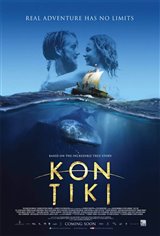In 1947, experimental ethnographer and adventurer Thor Heyerdahl wanted to prove that it was possible that the Peruvian natives, the Incas, had crossed the vast ocean and settled in the Polynesian islands. Scientists debated whether balsa rafts were able to last this journey. Heyerdahl tested this theory by building a balsa wood raft himself out of nine two-foot-thick balsa logs, ranging from 30 to 45 feet in length with balsa cross beams supporting a plaited bamboo deck - a copy of what the natives would have used centuries ago. On the raft with him were five other crew members and a macaw named Lorita. In charge of meteorological and technical research was Herman Watzinger, wireless operators Knut Haugland and Torstein Raaby, navigator Erik Hesselberg and Bengt Danielson, a Swedish sociologist who performed steward duties.
Heyerdahl named the raft Kon-Tiki, the Inca god of Sun and Storm. Kon-Tiki proved to be sea-worthy as during the 4,300 mile voyage, they survived lengthy storms and strong winds as they crossed the Pacific Ocean in 93 days before spotting land. After 101 days, Kon-Tiki was wrecked off the Raroia reef in the Tuamotu Islands. Heyerdahl and his crew members made it safely to shore where they were found by Polynesians who lived on the opposite side of the lagoon. The raft eventually washed right over the reef, was rescued and brought to Tahiti where it was shipped back to Norway with assistance of the French authorities and Norwegian shipowners. It is now displayed in the Kon-Tiki Museum.
Heyerdahl's book highlighting his experience The Kon-Tiki Expedition: By Raft Across the South Seas was published in 1948. A documentary telling the story of the Kon-Tiki won an Oscar in 1951 for Best Documentary Feature. More recently the story has been made into a drama. Kon-Tiki premiered in Norway in August 2012 and was nominated for a Best Foreign Language Oscar as well as Best Foreign Language Film at the Golden Globes. It's Norway's fifth Academy Award nomination and is the country's most expensive production to date.
